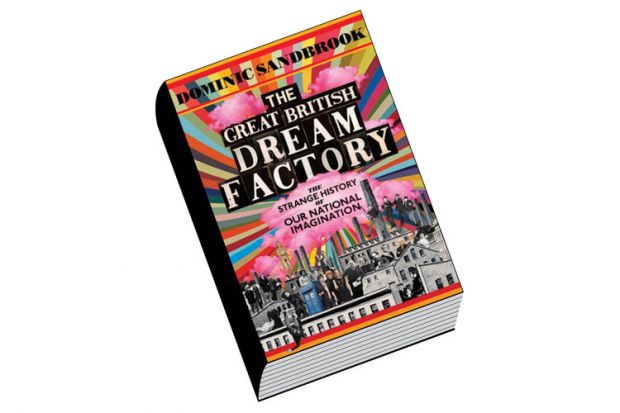This is a marvellous read. It’s important to say this first, for there are serious reservations to enter. Dominic Sandbrook takes, at gripping and talkative length, some dozens of the most popular television dramas between 1950 and the present, adds to them a populous throng of novels and films, throws in biographies of musicians and writers, and then places all these briskly and informatively in their context, tells us their stories and awards his prizes.
Coronation Street, J. Arthur Rank, Billy Bunter, James Bond, Agatha Christie, Catherine Cookson, Lord of the Rings, Doctor Who, the Beatles, Elton John, J. K. Rowling and a strange concluding reclamation of Billy Elliot on behalf of an ethos of self-improvement reel past in vivid colour and at unstoppable speed, like one of television’s own three-hour retrospectives: juicy, irresistible, restoring the past with all its delight, defeats and energy to the ageing spectator.
“Down in a flood of remembrance/I weep like a child for the past,” wrote D. H. Lawrence, and a great part of the pleasure of such a book is the reader’s calling out as the pages flicker past: stop, stop, what about Dennis Potter? What about Z Cars? What about Powell and Pressburger, Tommy Handley, The Goons? And then, tellingly, what about Boys from the Blackstuff and Edge of Darkness, two of the unmistakably great works of art made for British television?
Of course, this eager, burbling response would surely exhilarate our author, and quite right too. For he delights in the sheer, tumbling crowdedness of British popular culture over the past half century or so, crams in at a terrific pace the innumerable stories of its successes, and lends the status of heroism to his favourite figures.
The author catches with infectious excitement the cracking pace and headlong productivity of this teeming crowd. But what he signally fails to do – indeed what he does not even address – is to take his own subtitle as his proper subject. This book is about the dream factory all right, and a hectic, vivid, thriving place it proves to be. But it is not about “a strange history of our national imagination”; the only way he has of measuring the forcefulness of an imaginative production is by quoting the figures: sheer size, whether of audience or sales or cash.
This failure leaves his whole book critically short of the originality he surely hoped to offer. He makes no effort to identify imaginative power or intellectual distinction. He doesn’t, that is, tell us why some stories enthral us and others merely pass the time until we go to bed.
Sandbrook is a social historian by trade, and of a subject matter roughly similar to many successful historians of the 20th century: David Kynaston, Peter Hennessy, Niall Ferguson. His previous volume, Seasons in the Sun: The Battle for Britain 1974-79, candidly declared his political colours and his membership of the Daily Mail commentariat (all that old stuff about overflowing dustbins and bawling pickets). This new book has its lapses, and the central deficiency perhaps derives from a faint philistinism in his nature. By this I do not mean his entirely correct strictures on cultural studies and their heavy theory; rather, what is regrettable are his sneering allusions to “self-consciously highbrow types”, “the intellectuals” and his candid and often-expressed admiration for Margaret Thatcher.
This excellent variegated history, plainly as much fun to write as it is to read, urgently needs far more intellectual weight. The imagination works in many ways as it processes the narratives in front of it. “Escapism” may mean an evening watching Daniel Craig as James Bond followed by a plate of lasagne in Bella Italia; but each and every imagination may also enter and occupy the richly rendered world of Pride and Prejudice in the company of screenwriter Andrew Davies, and his inventiveness in presenting the dialogue left unspoken in the novel.
Indeed, the great tradition of the television adaptations of English literature serves as a crux for all Sandbrook has not done. The mighty novels of the 19th century have been reabsorbed by television into our collective imagination. Jane Austen’s precision view of feminine honour is rendered and recast with modernist delight as Elizabeth Bennet’s fierce and reflexive revision of social precedence, which brings down Lady de Bourgh.
This is not intellectual excess, nor is it heavy-duty theorising. It is the free, contemporary exercise of the imagination. Sandbrook has splendidly celebrated its playfulness, but he hasn’t brought out the wealth, depth and happiness of that play.
Fred Inglis is honorary professor of cultural history, University of Warwick.
The Great British Dream Factory: The Strange History of our National Imagination
By Dominic Sandbrook
Allen Lane, 688pp, £25.00
ISBN 9780241004654
Published 1 October 2015
Register to continue
Why register?
- Registration is free and only takes a moment
- Once registered, you can read 3 articles a month
- Sign up for our newsletter
Subscribe
Or subscribe for unlimited access to:
- Unlimited access to news, views, insights & reviews
- Digital editions
- Digital access to THE’s university and college rankings analysis
Already registered or a current subscriber? Login




